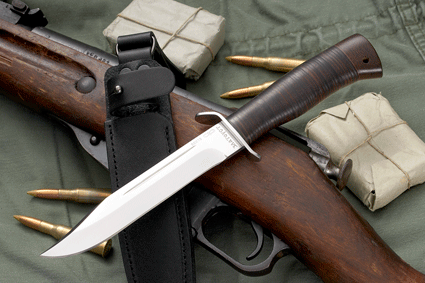For centuries the Russians have had a strange love/hate relationship with Finnish culture. During periods in history, Finland has been an unwilling colony of the Russian empire. Not unlike some Americans’ attitude about the countries to the south of us, the average Russian thought of their northern neighbors as a group of ultra violent, puukko knife-carrying thugs. The puukko was both feared in the hands of Finns and prized as a hideout weapon by Russia’s own street gangs and criminal subculture.
 The “Winter War” with Finland in 1939 taught the Russians the hard way why they needed a good, general-purpose infantry utility knife. Naturally, the first blade they thought of was the infamous puukko carried by their enemy. There was a general consensus that the puukko would penetrate cold weather military uniforms better with a sharper point. A “Bowie” style clip was added to the blade point to correct this. The Russians also felt a double cross-guard would make it safer for the user in close combat. The end product was the issue NR-40 “Nozh Razedchika” or “Scout’s knife.” “Scout” in this context meaning “infantry recon man.”
The “Winter War” with Finland in 1939 taught the Russians the hard way why they needed a good, general-purpose infantry utility knife. Naturally, the first blade they thought of was the infamous puukko carried by their enemy. There was a general consensus that the puukko would penetrate cold weather military uniforms better with a sharper point. A “Bowie” style clip was added to the blade point to correct this. The Russians also felt a double cross-guard would make it safer for the user in close combat. The end product was the issue NR-40 “Nozh Razedchika” or “Scout’s knife.” “Scout” in this context meaning “infantry recon man.”
NR-40 Variants
Like most military equipment produced by more than one source during a wartime emergency, the NR-40 can be found with a number of small variations in handle material and blade style. The most common version is normally around 6 inches in blade length with a steel guard and wood handle scales. NR-40-style knives are said to have remained popular with the troops up through the early 60’s. Several versions were also produced by Soviet satellite countries during this same period. Compared to the current crop of high-tech “Spec Ops operator” knives, the NR-40 is not much to look at but it obviously got the job done for thousands of troops during WW-II.
Advertisement — Continue Reading Below
Recently while attending the IWA trade show (European version of SHOT Show) in Nuremburg, Germany, I noticed the Russian knife company, A&R Company, Ltd of Zlatoust was offering a replica of the NR-40 in several minor variations. Talking to the company, I soon found that the main differences between the models were that about half were “civilian” legal with the others restricted to “military sales only.” As Ralph Mroz recently stated in an article in Tactical Knives, the Russians have laws that restrict both the width and blade thickness of knives offered on the civilian market. I found the military knives were roughly 1/8-inch thick at the spine and 15/16-inch wide, not really massive by American standards. The Russian street-legal versions were only a mere fraction of an inch less in thickness and blade width, nothing I would think you would really notice in close combat.
Gained In Translation
At first, I was told I could only have a sample of the civilian scout knife as, if I understood the translator right, the military models had been officially checked out of Russia and needed to be accounted for when they returned. After some discussion between the factory reps in Russian, the head knife designer called Moscow and received permission for the company to let me have a sample of the military scout knife.
I have to say this knife fits my own thoughts on a practical infantry knife very well. The knife I returned to the States with has a 15 cm long blade, 4 mm thick, and 24 mm wide. Its handle is made up of stacked leather washers with a Micarta-like material for a pommel. Other models were offered in a variety of woods including curly birch, which made the knives look very much like puukkos. There is what appears to be a serial number on the spine of my knife and a “hammer and sickle” stamped on the reverse side. Total weight in the sheath, a very reasonable 9 ounces.
Advertisement — Continue Reading Below
Frankly, this is the type of knife that I think should be issued to the U.S. Army. The big problem would be you would need to teach the troops that knives are for cutting, not chopping holes in concrete walls, prying open doors, cutting wire and other chores requiring indestructible tools. Russian military equipment may not be fancy, but it has always been practical.
For more information please contact www.zlatoust-air.ru.























